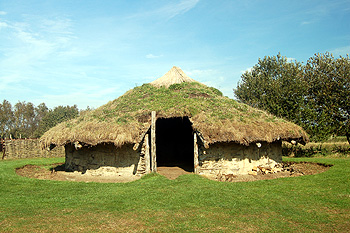Yelden Before 1086

A reconstruction of an Bronze Age round house at Flag Fen October 2011
The Bedfordshire Historic Environment Record [HER] contains information on the county's historic buildings and landscapes and summaries of each entry can now be found online as part of the Heritage Gateway website. Excavations at the rear of the High Street in 1992 produced evidence for occupation from prehistory into the Middle Ages [HER 15618]. Flint flakes and a core were probably from the Neolithic or Bronze Age. Romano-British finds included a clamp, a nail, two pots and a pot sherd, a quern for grinding corn and slag from a ditch, a gully, an enclosure and a pit. Anglo-Saxon evidence comprised a nail, a pot and some pot sherds.
North-east of Newton Bromswold but just on the Yelden side of the county boundary is a small enclosure evidenced by cropmarks [HER 4422]. These are thought to represent occupation from the Iron Age through to the Anglo-Saxon period on the evidence of pot sherds found on fieldwalking.
An indistinct circular cropmark north-east of Bottom Farm may represent a ring ditch. These are the remains of barrows and date to the Bronze Age [HER 16570]. Other possible prehistoric cropmarks include a rectangular enclosure north of Newton Bromswold [HER 370], a rectangular enclosure with double ditches west of Crowfield Farm [HER 1675], a square enclosure north-east of the village [HER 8313], small rectangular enclosures running south-west to north-east along a ridge top south-west of Chelveston Airfield [HER 14030] and a scatter of small enclosures north-west of manor Farm [HER 14005].
A Roman villa has been identified in the parish [HER 340]. Roman pottery, building stone and mosaic fragments were brought up by steam ploughing and an investigation in 1881 found only slight foundations indicating that the ploughing had destroyed most of the site. A single bronze coin of the British usurper Carausius (286-293) was found in 1886, surviving records suggest it may have been part of a hoard [HER 6524].
In 2000 evaluation was undertaken on a field system at Spring Lane [HER 18891]. Archaeological remains indicated it was a system originating in the Anglo-Saxon period which survived into the Norman period.